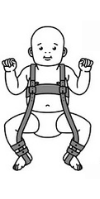The basis for the provision of a Pavlik harness in infancy was the epidemiological observation that there were strong differences in the incidence of hip dysplasia and dislocation around the world. In regions where infants were swaddled early in hip extension (e.g. Alaska, Ecuador, Prussia), these hip disorders occurred in clusters, whereas in regions where infants were carried in the “spread-squat position” (e.g. many regions in Africa), they were rarely observed. The orthopaedist Salter called the carrying of the child in the sling or on the hip of the adults, the “human position”.
Since a child’s hip has little bony-cartilaginous shape retention at birth, it must mature postnatally. This is supported by a strong hip flexed and abducted position. From about 1900, conservative reduction with subsequent prolonged fixation in a cast became established, however re-dislocation or necrosis of the femoral head occurred frequently.
During World War II Czech orthopaedist Arnold Pavlik developed a harness to keep the hip adducted and flexed but also allowed for natural movement. So successful was Pavlik’s harness that it has become standard treatment. That Pavlik’s invention, born under Nazi rule and lived under Czechoslovakian communist rule, emerged to become the global treatment for infantile hip dysplasia and dislocation is testament to the success of the principle of the treatment.
Description provided by Karoline Munsch of Germany
References:
Tönnis D., Legal H. 1984. Die angeborene Hüftdysplasie und Hüftluxation im Kindes- und Erwachsenenalter: Grundlagen, Diagnostik, konservative und operative Behandlung. Springer.
Mittelmaier H. 1961. Beitrag zur funktionellen Therapie und Spontanreposition der angeborenen Luxationshüfte mit Spreizhöschen und Pavlikbandage. Archiv für orthopädische und Unfall-Chirurgie, 52, 465-522.

